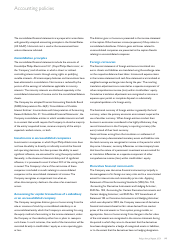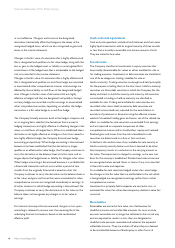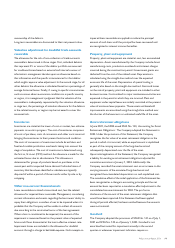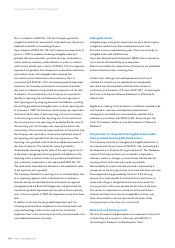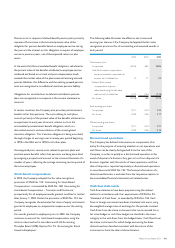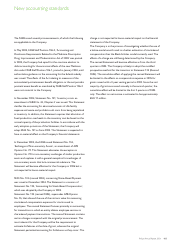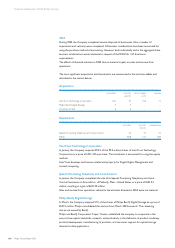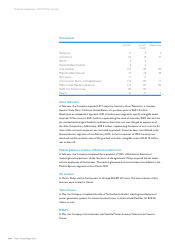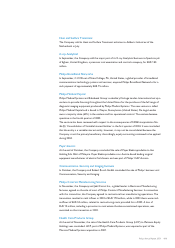Philips 2004 Annual Report Download - page 102
Download and view the complete annual report
Please find page 102 of the 2004 Philips annual report below. You can navigate through the pages in the report by either clicking on the pages listed below, or by using the keyword search tool below to find specific information within the annual report.Advertising
Advertising costs are expensed when incurred.
Provisions and accruals
The Company recognizes provisions for liabilities and probable
losses that have been incurred as of the balance sheet date and for
which the amount is uncertain but can be reasonably estimated.
Provisions of a long-term nature are stated at net present value
when the amount and timing of related cash payments are fixed or
reliably determinable unless discounting is prohibited under US
GAAP. Short-term provisions are stated at face value.
The Company applies the provisions of SOP 96-1, ‘Environmental
liabilities’ and SFAS No. 5, ‘Accounting for Contingencies’ and
accrues for losses associated with environmental obligations when
such losses are probable and reasonably estimatable. Additionally,
in accordance with SOP 96-1, the Company accrues for certain
costs such as compensation and benefits for employees directly
involved in the remediation activities. Measurement of liabilities is
based on current legal requirements and existing technology.
Liabilities and expected insurance recoveries, if any, are recorded
separately. The carrying amount of liabilities is regularly reviewed
and adjusted for new facts or changes in law or technology.
Restructuring
In June 2002, the FASB issued SFAS No. 146, ‘Accounting for
Costs Associated with Exit or Disposal Activities’
The provision for restructuring relates to the estimated costs of
initiated reorganizations that have been approved by the Board of
Management, and which involve the realignment of certain parts of
the industrial and commercial organization. When such
reorganizations require discontinuance and/or closure of lines of
activities, the anticipated costs of closure or discontinuance are
included in restructuring provisions.
Statement 146 requires that a liability be recognized for those
costs only when the liability is incurred, i.e. when it meets the
definition of a liability. Statement 146 also establishes fair value as
the objective for initial measurement of the liability.
Liabilities related to one-time employee termination benefits must
be recognized ratably over the future service period when those
employees are required to render services to the Company, if that
period exceeds 60 days or a longer legal notification period. The
Statement is effective for exit or disposal activities that are
initiated after December 31, 2002 and has been adopted by the
Company as of January 1, 2003.
Employee termination benefits covered by a contract or under an
ongoing benefit arrangement continue to be accounted for under
SFAS No. 112, ‘Employer’s Accounting for Postemployment
Benefits’ and are recognized when it is probable that the
employees will be entitled to the benefits and the amounts can be
reasonably estimated.
Guarantees
In 2003, the Company adopted FASB Interpretation No. 45,
‘Guarantor’s Accounting and Disclosure Requirements for
Guarantees, Including Indirect Guarantees of Indebtedness of
Others’. In accordance with this Interpretation, the Company
recognizes, at the inception of a guarantee that is within the scope
of the recognition criteria of the Interpretation, a liability for the
fair value of the obligation undertaken in issuing the guarantee.
Debt and other liabilities
Debt and liabilities other than provisions are stated at amortized
cost. However, loans that are hedged under a fair value hedge are
remeasured for the changes in the fair value that are attributable
to the risk that is being hedged.
Currently, the Company does not have any financial instruments
that are affected by SFAS No. 150, ‘Accounting for Certain
Financial Instruments with Characteristics of both Liabilities and
Equity’.
Revenue recognition
The Company recognizes revenue when persuasive evidence of an
arrangement exists, delivery has occurred or the service has been
provided, the sales price is fixed or determinable, and collectibility
is reasonably assured. For consumer-type products in the
segments Lighting, DAP and Consumer Electronics, as well as for
certain products in the Semiconductors segment, these criteria are
generally met at the time the product is shipped and delivered to
the customer and, depending on the delivery conditions, title and
risk have passed to the customer and acceptance of the product,
when contractually required, has been obtained, or, in cases where
such acceptance is not contractually required, when management
has established that all aforementioned conditions for revenue
recognition have been met and no further post-shipment
obligations exist. Examples of the above-mentioned delivery
conditions are ‘Free on Board point of delivery’ and ‘Costs,
Insurance Paid point of delivery’, where the point of delivery may
be the shipping warehouse or any other point of destination as
agreed in the contract with the customer and where title to and
risks for the goods passes to the customer.
For products that require substantive installation activities by the
Company, such as those related to the equipment sales of the
Medical Systems segment and parts of the Other Activities
segment, revenue recognition occurs when the aforementioned
criteria for revenue recognition have been met, installation of the
101Philips Annual Report 2004








